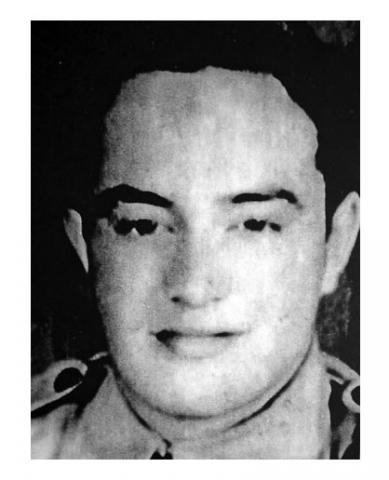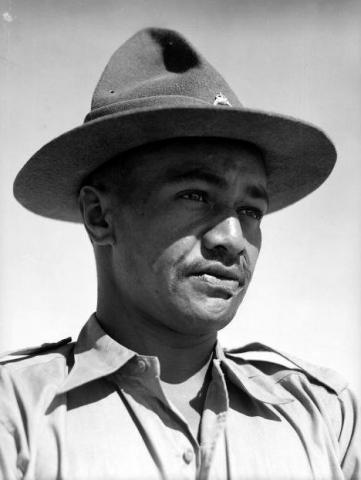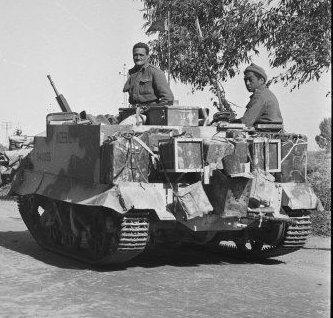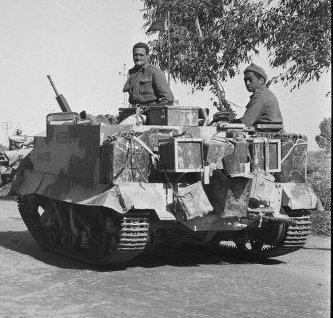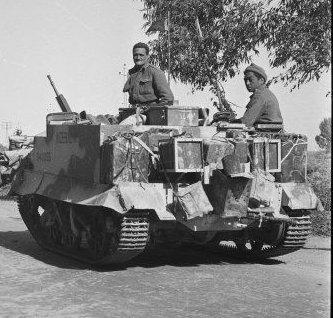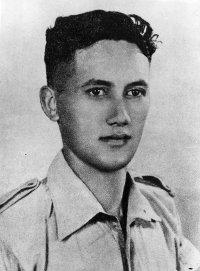<p class="MsoNormal" style="margin: 0cm 0cm 8pt;"><strong>Posthumous award of the Military medal to Private Morgan Ratu Potae <span>during the investiture ceremony on 13th of September 1947 at Uepohatu marae. His father Enoka Potae received the award on his behalf. Seventeen decorations were presented to service men and women who had served abroad and on the home front.</span></strong></p><p>The <acronym title=" open space or courtyard where people gather, generally in front of a main building or meeting house; forum of social life; modern meaning: the complex of buildings surrounding the courtyard and the courtyard itself">marae </acronym><em></em>hosted events held on the 12th and 13th of September that included cultural competitions with local school children and the opening of the Uepohatu War Memorial Hall. The hall was built to commemorate East Coast soldiers who died during the two World Wars. A reunion of ex-service people (including members of the Maori Battalion) was also held. </p><p>The gathering was an important one, attended by thousands including the Prime Minister Peter Fraser, the Leader of the Opposition Sidney Holland and other members of Parliament. Sir Bernard Freyberg, the Governor General opened the hall and unveiled two memorial tablets inside.</p>
Media library
Audio
<p><strong>Sound file</strong> from Ngā Taonga Sound & Vision, ref: <a href="https://www.ngataonga.org.nz/collections/catalogue/catalogue-item?recor…;. Any re-use of this audio is a breach of copyright.</p><p><strong>Image </strong>from Nga Taonga a Nga Tama Toa Trust</p></div>
<p class="MsoNormal" style="margin: 0cm 0cm 8pt;"><strong>Posthumous Military medal awarded to Private Kura Edwards <span>during the investiture ceremony on 13th of September 1947 at Uepohatu marae. His mother received the award on his behalf. Seventeen decorations were presented to service men and women who had served abroad and on the home front.</span></strong></p><p>The <acronym title=" open space or courtyard where people gather, generally in front of a main building or meeting house; forum of social life; modern meaning: the complex of buildings surrounding the courtyard and the courtyard itself">marae </acronym><em></em>hosted events held on the 12th and 13th of September that included cultural competitions with local school children and the opening of the Uepohatu War Memorial Hall. The hall was built to commemorate East Coast soldiers who died during the two World Wars. A reunion of ex-service people (including members of the Maori Battalion) was also held. </p><p>The gathering was an important one, attended by thousands including the Prime Minister Peter Fraser, the Leader of the Opposition Sidney Holland and other members of Parliament. Sir Bernard Freyberg, the Governor General opened the hall and unveiled two memorial tablets inside.</p>
<p><strong>Sound file</strong> from Ngā Taonga Sound & Vision, ref: <a href="https://www.ngataonga.org.nz/collections/catalogue/catalogue-item?recor…;. Any re-use of this audio is a breach of copyright.</p><p><strong>Image </strong>Bull, George Robert, 1910-1996. Private K Edwards of the 28th New Zealand (Maori) Battalion, Military Medal winner, Egypt - Photograph taken by George Robert Bull. New Zealand. Department of Internal Affairs. War History Branch :Photographs relating to World War 1914-1918, World War 1939-1945, occupation of Japan, Korean War, and Malayan Emergency. Ref: DA-04141-F. Alexander Turnbull Library, Wellington, New Zealand. <a href="http://natlib.govt.nz/records/22736292">http://natlib.govt.nz/records/2…;
<p class="MsoNormal" style="margin: 0cm 0cm 8pt;"><strong>Presentation of the Military medal to Warrant Officer Te Kapunga Harawira <span>during the investiture ceremony on 13th of September 1947 at Uepohatu marae. Seventeen decorations were presented to service men and women who had served abroad and on the home front.</span></strong></p><p>The <acronym title=" open space or courtyard where people gather, generally in front of a main building or meeting house; forum of social life; modern meaning: the complex of buildings surrounding the courtyard and the courtyard itself">marae </acronym><em></em>hosted events held on the 12th and 13th of September that included cultural competitions with local school children and the opening of the Uepohatu War Memorial Hall. The hall was built to commemorate East Coast soldiers who died during the two World Wars. A reunion of ex-service people (including members of the Maori Battalion) was also held. </p><p>The gathering was an important one, attended by thousands including the Prime Minister Peter Fraser, the Leader of the Opposition Sidney Holland and other members of Parliament. Sir Bernard Freyberg, the Governor General opened the hall and unveiled two memorial tablets inside.</p><h2><strong>Transcript</strong></h2><p class="MsoNormal" style="margin: 0cm 0cm 8pt;">To receive the Military medal – Warrant Officer Te Kapunga Harawira, New Zealand Military Forces. During the attack at Miteiriya Ridge on the 23<sup>rd</sup> of October 1942, Warrant Officer Harawira displayed qualities of leadership that greatly inspired his men. Despite enemy fire he was always to be found on his feet encouraging his men, and throughout the advance he was tirelessly aggressive. <br />Warrant Officer Harawira.</p>
<p><strong>Sound file</strong> from Ngā Taonga Sound & Vision, ref: <a href="https://www.ngataonga.org.nz/collections/catalogue/catalogue-item?recor…;. Any re-use of this audio is a breach of copyright.</p><p><strong>Image </strong>from Nga Taonga a Nga Tama Toa Trust</p>
<p class="MsoNormal" style="margin: 0cm 0cm 8pt;"><strong>Presentation of the Military Medal to Lieutenant Watene Pahau <span>during the investiture ceremony on 13th of September 1947 at Uepohatu marae. Seventeen decorations were presented to service men and women who had served abroad and on the home front.</span></strong></p><p>The <acronym title=" open space or courtyard where people gather, generally in front of a main building or meeting house; forum of social life; modern meaning: the complex of buildings surrounding the courtyard and the courtyard itself">marae </acronym><em></em>hosted events held on the 12th and 13th of September that included cultural competitions with local school children and the opening of the Uepohatu War Memorial Hall. The hall was built to commemorate East Coast soldiers who died during the two World Wars. A reunion of ex-service people (including members of the Maori Battalion) was also held. </p><p>The gathering was an important one, attended by thousands including the Prime Minister Peter Fraser, the Leader of the Opposition Sidney Holland and other members of Parliament. Sir Bernard Freyberg, the Governor General opened the hall and unveiled two memorial tablets inside.</p>
<p><strong>Sound file</strong> from Ngā Taonga Sound & Vision, ref: <a href="https://www.ngataonga.org.nz/collections/catalogue/catalogue-item?recor…;. Any re-use of this audio is a breach of copyright.</p><p><strong>Image </strong>from Nga Taonga a Nga Tama Toa Trust</p>
<p class="MsoNormal" style="margin: 0cm 0cm 8pt;"><strong>Presentation of the Military Cross to Lieutenant Colonel Arapeta Awatere (DSO) during the investiture ceremony on 13th of September 1947 at Uepohatu marae. Seventeen decorations were presented to service men and women who had served abroad and on the home front.</strong></p><p>The <acronym title=" open space or courtyard where people gather, generally in front of a main building or meeting house; forum of social life; modern meaning: the complex of buildings surrounding the courtyard and the courtyard itself">marae </acronym><em></em>hosted events held on the 12th and 13th of September that included cultural competitions with local school children and the opening of the Uepohatu War Memorial Hall. The hall was built to commemorate East Coast soldiers who died during the two World Wars. A reunion of ex-service people, including members of the Maori Battalion, was also held. </p><p>The gathering was an important one, attended by thousands including the Prime Minister Peter Fraser, the Leader of the Opposition Sidney Holland and other members of Parliament. Sir Bernard Freyberg, the Governor General opened the hall and unveiled two memorial tablets inside.</p>
<p><strong>Sound file</strong> from Ngā Taonga Sound & Vision, ref: <a href="https://www.ngataonga.org.nz/collections/catalogue/catalogue-item?recor…;. Any re-use of this audio is a breach of copyright.</p><p><strong>Image </strong>Kaye, George Frederick, 1914-2004. Kaye, George 1914- : Arapeta Awatere. New Zealand. Department of Internal Affairs. War History Branch :Photographs relating to World War 1914-1918, World War 1939-1945, occupation of Japan, Korean War, and Malayan Emergency. Ref: DA-08379. Alexander Turnbull Library, Wellington, New Zealand. <a href="http://natlib.govt.nz/records/22570383">http://natlib.govt.nz/records/2…;
<p><strong>Te Tohara (Charlie) Mohi grew up in Pakipaki. He embarked for war in 1941 and served with the Maori Bren-carrier platoon. </strong><strong>Charlie returned on furlough in 1945, see the photo <a href="/node/22923">here</a>.</strong></p><p><strong>Charlie recounts the death of his very close relative during the war. They had grown up together in Wairoa.<br /></strong></p><h2><strong>Transcript</strong></h2><p>A, noho maua ko taku…mea… he tuakana noku no Te Wairoa. Ka noho maua i runga i tona Bren Carrier, kei reira noho maua e korero ana, e kai paipa ana, oooo katahi a voomsh. Kare au e mohio he aha, engari i mua tonu o nga Bren Carrier he wahi paku nei mo to pu. Uru mai te hoata i roto i taua wahi, pa atu tetahi huri mai, pakaru katoa tenei waenga, hemo tonu atu. Ka timata taku tangi, a, ka haere mai etahi o matou, a ka hikingia matou ki waho, ka maungia, takaingia i ro blanket, a tapukengia ia.<br /> <br /> Tarai au ki te mahi tona waka kia haere. Kare rawa atu e haere. A, ka maungia atu au nga grenades. E toru nga grenades tangongia nga pin, meingia atu au ki runga tonu te, te taake o nga penehini, taamingia atu he wahi ki runga, hei pupuri. A, kua mahue koe, mahau pea, mo Amu(?) he Tiamana hei utu mo te, ma te tangata ko, taku tuakana. </p><p><strong><br /></strong></p>
<p><strong>Sound file</strong> from Ngā Taonga Sound & Vision, ref: <a href="https://www.ngataonga.org.nz/collections/catalogue/catalogue-item?recor…;. Any re-use of this audio is a breach of copyright.</p><p><strong>Image<br /></strong>Crop of <a href="/node/3856" target="_blank">full photo</a> - Bren-carrier platoon leads the Maori Battalion into Tripoli, 23 January 1943. Sgt Te Whiu Purei (standing) and Charlie Mohi, seated.</p>
<p><strong>Te Tohara (Charlie) Mohi grew up in Pakipaki. He embarked for war in 1941 and served with the Maori Bren-carrier platoon. </strong><strong>Charlie returned on furlough in 1945, see the photo <a href="/node/22923">here</a>.</strong></p><p><strong>In this recording Charlie discusses returning to Kaponga Box in a vehicle that kept breaking down. Once back at camp his comrades comandeered another vehicle Charlie had acquired to raid supplies from the NAAFI at Derna. <br /></strong></p><h2><strong>Transcript</strong></h2><p>A, i nga toru o nga haora i te ata ka timata matou te whakararangi haere. Ko matou nga Bren Carriers i waho, ko nga anti-tank me nga waka mau nga hoia. Te tuatahi ko nga hoia, ka haere atu ratou, ka kokiritia ratou, whakawatea te huarahi. Kare ano he roa, kua taima katoangia, ka haramai nga taraka, mahau tonu e piki atu ki tena taraka, ki tena taraka. Kare hoki e whanga, me kare koe e piki atu, nohou tena he, mahue atu koe. Ka timata matou i nga taha, ka haere mai nga taraka. Kei te rongo matou e umere ana, e haka ana nga, a matou hoia i mua. Ma ratou te wahi tuatahi, te kokiri tuatahi hei whakawatea nga huarahi mo nga waka nei. Haere atu nga waka tena e peka. Kare rawa atu nga waka e taapu, mahau tonu e peke haere, e peke haere ki runga i te mea e tata atu ana koe. Ka haere matou. Taku hoa, no Whanau-a-Apanui, he De La Croix, koia toku, taku heihana i tera wa. And, to matou waka, e tama, pakarukaru nei, kare e haere, pakarukaru nga tracks. A, engari i te mohio tonu matou kua korero mai ngia e nga apiha, me ka mahue koe kei te haere matou ana ka te huarahi. Kua homaingia nga compass bearings me era mea. Mohio tonu matou kei te hoki matou ki Kaponga Box. (Cough). So, ka haere matou. </p><p>Tetahi wa, ka haere maua, ka ‘stuck’ atu to maua waka i roto ‘slit trench’. Kei te kite tonu au nga tangata e tarai ana te pehea, te piki atu ki waho. E karawhiuangia atu e to maua waka, e haere tonu atu. Kua tata tonu te marama, kua pakaru to maua waka. Te pakaru tuatahi tera. Ka heke maua, kei te haere ke etahi, kei te haere, kei te mahi ma to maua waka. A, ka oti a maua, ka haere ano maua, ka pakaru ano. Kare ano e taea i te maero kua pakaru, pakaru…a, i runga i era pakarukarutanga, e tama, kua mahue maua. Kei te karanga mai etahi o matou, “Hey, hei aha waea ke to waka haere mai ki runga i to matou.” E, kei te karanga taku, “Ei, kei para noa to koutou, pehea hoki maua.” Ah well, ka mahue maua. Engari kare maua i mataku, kei te mohio maua kei te haere matou ki whea. And kei a maua nga mapi, hei mau ia maua i reira. He nui nga kai, haere tonu atu koe nga waka pakarukaru maungia koe te wai mahau. Kua meingia atu nga penehini ki roto i to waka. E rua ra pea maua e haere pera haere ana ka tae maua ki te, ki te wahanga e haeretia nei e matou. To matou taenga i reira, i mua to maua taenga i reira i kite tetahi taraka ano no nga Inia, a, whakakiingia maua te penehini, ka tareiwa te taraka mea tau, te Bren Carrier. Ka tae atu maua ki Kaponga Box, i reira katoa o matou hoa e karikari ana e o ratou rua. Hehe. Taku matekai, e kare taea hoki e horoi, e toru ke nga ra, mataku te tango nga putu hika, kei makere atu nga waewae. Tae atu matou, a, tae atu maua, a, haere au i te kai. A, e kai ana, ka haere mai etahi o matou – “Ei, homai te taraka i a matou, kei te haere matou ki te, ki Derna.” <br /> “He aha hoki ta koutou haere ki Derna?”<br /> “Oh, ko mahue katoa te taone ra.” <br /><br /> E kei reira e korero ana, e tama, ko te mahi a te pia kei roto i nga NAAFI. E kii! Oh well, taihoa kei te haere atu au. Tama, ko te roa o oku hoa e whanga ana moku, haere tonu atu ratou. To ratou haerenga atu, i korero mai tenei, no mutu ra no te whawhai ka korero mai. </p><p>…to matou, a, te taenga atu o aku hoa ki taua wahi nei mohio tonu ratou ko te wharenui tonu, kei reira te NAAFI nga pia nei. </p><p>Ka heke ana ratou ki roto o Derna, titiro ratou, “oh no ra, kare nei he tangata.” Tae atu ratou ki tetahi o nga tiriti, huri tonu atu te tiriti, kare ano he, he toru iari pea – boom! Karawhiu mai e te Tiamana. Huri tonu atu to ratou waka, mauherehere katoa ratou. To matou hoki mai ki te kainga, ka kite au ia Hori, Hori mea Ellison i te waapu e pohiri ana mai i a matou. Engari i taua wa ta matou mahi e whai haere kua pakaru katoa hoki e mea, well, i muri mai i tera ka pakaru a Alamein, ka puta mai matou, ka whai haere matou i te Tiamana. </p><div> </div><p><strong><br /></strong></p>
<p><strong>Sound file</strong> from Ngā Taonga Sound & Vision, ref: <a href="https://www.ngataonga.org.nz/collections/catalogue/catalogue-item?recor…;. Any re-use of this audio is a breach of copyright.</p><p><strong>Image<br /></strong>Crop of <a href="/node/3856" target="_blank">full photo</a> - Bren-carrier platoon leads the Maori Battalion into Tripoli, 23 January 1943. Sgt Te Whiu Purei (standing) and Charlie Mohi, seated.</p>
<p><strong>Te Tohara (Charlie) Mohi grew up in Pakipaki. He embarked for war in 1941 and served with the Maori Bren-carrier platoon. </strong><strong>Charlie returned on furlough in 1945, see the photo <a href="/node/22923">here</a>.</strong></p><p><strong>Here Charlie recounts the situation directly after the Battle at El Alamein - buring dead comrades, dysentry suffered by many soldiers, erecting make-shift holding bays for prisoners and looting. </strong></p><p><strong>He also pays tribute to one of the Battalion's Padres Wi Huata, who he says cared so much for the soldiers. </strong><strong></strong></p><h2><strong>Transcript</strong></h2><p>Tera kainga a Alamein, te nui a matou tangata i matemate i reira kare e taea atu ki te, ki te tapuke. Pai noa a matou, engari no nga Pakeha, nga Tiamana, ka waiho ano a ratou tupapaku i kona takoto ai. Engari te pai noa matou o te mea Maori. Kare rawa atu te waenganui o matou, ka taea atu matou ki reira, mauria mai, ka tapuke. Ko tera te mea, e miharo ana matou kia Wi. He nui ke atu te mahi a tera tangata i mua i nga hoia, i muri. Tetahi tangata tino toa tera. He tio toa penei mo tona mahi ne. He minita, tona whakaaro he tapukengia ia, ona tupapaku, ana tamariki. Haere ai, kuhu haere a Wi kia taea ki reira me ona hoa e mamaengia i te kainga. Ka hoki a matou. </p><p>I te nui o nga tupapaku nei, kare e taea, kare e tapukengia ka pangia matou i te mate, te dysentery. Ka haere hoki nga rango i taua wa te wera, taua rango, ka kite koe i nga pikita i nga, etahi o nga iwi mangu nei – a pera tonu matou. Kei te haere katoa i nga rango, i nga waha, ka tu haere te waha huri tonu te rango ki roto. Kei te kai koe i to kai, me to pu, kei te pena koe… kei te… ki roto i to waha. Kua maungia ratou i nga, nga paitini nga mate noa atu ki runga, i runga, ki runga i a matou kai, e matemate katoa matou. </p><p>Kua kite au i te papa, tetahi o nga papa o te poi nei i a Bully – tangata nui. E tama, te karawhiutanga a te, a te dysentery, paku iti noa iho. Ko tera te mate o taua wahi nei. </p><p>Engari te pakarutanga i a matou i nga mahi a te Tiamana i reira, ka puta matou ki waho, ka oma te Tiamana. Ta matou mahi, te whai haere i muri a ia. Engari te mea nui i reira ko nga hoia mo te tauiwi i tera wa, mo nga Tiamana, nga Itariana, te pakarutanga o Alamein, kare koe e mohio he aha i ora ai era. Te mahi a matou pu hoata nei nga mea nunui ka paku mai ka tau ki konei ka tau atu tetahi o nga hoata ki kona ki kona, e hoa, pehea e ora ai te tangata ki raro? Kite tonu matou etahi e haere porangi noa iho ana. Kare, kua waikare, kua wairangi katoa. Kare e mohio he aha a ratou mahi, he aha ra no. Oh, tino he rawa atu. </p><p>And, ka timata o ratou nga Tiamana, nga Itariana, nga mea i mahue ne katahi he waka e whakahokia i a ratou. Ka waihongia atu ki reira ka haerere. Ta matou mahi, te mamae ke, ki nga barb wire, I te wa, i nga wahi herehere. Ahua roa tonu matou i reira. Ko te mea pai kia matou, ko matou hoki te iwi ka tukua atu kei te haere i te tiki mahi. Ko te mea tuatahi kei te titiro kei whea nga waati, kei whea nga pu, kei hea nga camera, oh. Rawe hoki matou, kare e pai e nga mea ki a koe kia tangohia hoki, pai ke atu me homaingia ke koe kia matou. </p><p><strong><br /></strong></p>
<p><strong>Sound file</strong> from Ngā Taonga Sound & Vision, ref: <a href="https://www.ngataonga.org.nz/collections/catalogue/catalogue-item?recor…;. Any re-use of this audio is a breach of copyright.</p><p><strong>Image<br /></strong>Crop of <a href="/node/3856" target="_blank">full photo</a> - Bren-carrier platoon leads the Maori Battalion into Tripoli, 23 January 1943. Sgt Te Whiu Purei (standing) and Charlie Mohi, seated.</p>
<p><strong>Signalman Tamaio Paiki talks about entering Tobruk after the seige. He served with the Signals Division. In this recording he recounts his observations of the battle leading up to it. </strong></p><p><strong>Tamaio lived in Christchurch where he was a reporter on the Star-Sun newspaper. He also taught children in England as a lecturer on an Imperial Institute panel that worked under the Ministry of Education to spread information about the Commonwealth. <a name="ftnref1"></a>[<a href="#ftn1">1</a>] He died in 1984 and is buried at Temuka Cemetery.<br /></strong></p><h2>Transcript</h2><p>Ki te iwi, ki nga hapu, ki nga marae, i Aotearoa, i te Waipounamu, tena koutou. Ki aku hakui, i Korerehu a Hariata. Ki aku tuahine - Pirihira, Amiria, ki taku kaumatua a Wiremu Mihaka. Ki aku tamariki - Winston, Jill and Gaynor, Barry, Bill me Tuhuru. Tenei te aroha, tena koutou, tena koutou, tena koutou. </p><p>Naturally, I am proud to be the first full-blood representative of my race to arrive in the fortress of Tobruk. My unit was the first, or rather among the first to pass along the narrow east to west corridor from the desert into Tobruk which our air force, armoured units and artillery had smashed open through the strongly held enemy lines. We arrived in the early hours of the morning after a gruelling all night movements through the shell rid area. Incidentally we made this journey after being shelled continuously for two days and after repelling vicious, futile attacks by a large German force. Looking back over the three or four weeks when our division was in action, one’s mind simply sieves with the vivid memories of swift desert journeys. Our mechanised columns attacking relentlessly at many widely separated points. Every day, every night was full of incident and for me to discuss in detail the events of any particular day would take much more time than this broadcast permits. My most vivid recollection of our time out in the blue, is the tank battle which raged for two days when we were just north of Sidi Rezegh and which was in clear view about 7000 yards to the south and east. Enemy artillery together with mobile infantry stood in readiness to support their tanks. Our reconnaissance patrols reported that they were a numerically stronger force at this point than we were and that it was evident that they would attempt to crash through to re-join their other forces to the west. Through powerful binoculars I saw our light and heavy armoured units move forward just below the edge of an escarpment over which the Hun tanks must come. All day long on the first day the enemy tanks tried to come over but time and again they were driven back. The enemy renewed his attempts on the following morning only to meet the same determined resistance. The fight took a sudden change when a squadron of about twenty fighter planes from the RAF, god bless ‘em, started to straff his infantry. How we cheered when we saw the Jerries running in all directions trying to evade the hail of bullets and bombs from the air. Nor were their troubles ended here, our artillery suddenly opened fire and even in that first salvo several of their lorries burst into flames. It was a dramatic site and I was among those who climbed on top of a lorry and had a real grandstand view of it all. Before coming into the desert I like many others in the division wondered in what circumstances I would see or meet my first Hun. Of course I imagined he and I would be pelting lead and steel at each other but such was not the case. There were thirty one in the first group of Germans I saw. They passed through the lines of my unit, early one morning, having given themselves up as prisoners during the night. From a close inspection of them, my impression was that they had been fully fed and their clothes were of very indifferent quality. They were the first of several hundred prisoners I saw that day. From my own observations here in the Middle East, I really as one of the ranks would like the Prime Minister and the people of New Zealand to know three things: one – we will always earnestly strive to maintain the traditionally high name that New Zealanders have as a fighting force and so hasten the day of victory. Two – thanks to the sacrifices and the work of the people home there in our Dominion, we here are foremost among the best equipped soldiers in the world and three – the officers who direct the operations of the New Zealand division and particularly the officers of my own unit are men whose courage, ability and leadership have won the unstinted admiration of the men in the ranks. </p><p>E te iwi, ka mutu i konei, tenei a Te Maio Paiki. Hei konei ra, hei konei ra, hei konei ra.</p><h3>Footnotes</h3><p><a name="ftn1"></a>[<a href="#ftnref1">1</a>] <a href="http://teaohou.natlib.govt.nz/journals/teaohou/images/Mao16TeA/Mao16TeA…; target="_blank">Te Ao Hou</a>, No 16 (October 1956), p.13</p>
<p><strong>Sound file</strong> from Ngā Taonga Sound & Vision, ref: <a href="https://www.ngataonga.org.nz/collections/catalogue/catalogue-item?recor…;. Any re-use of this audio is a breach of copyright.</p>
<p><strong>On 28 February 1943, while stationed outside Tripoli, 2/Lt Moana Ngarimu was one of a group of selected members of the Maori Battalion who broadcast messages home to New Zealand. 11 men were selected from each of the Battalion’s tribal companies to represent that company’s “tribes” and “sub-tribes” equally. Each soldier was to prepare an appropriate 30 second greeting in writing, in Maori or English, preferably in Maori. Details referring to this were noted in <a href="http://www.nzhistory.govt.nz/files/documents/28mb/RO22-14.pdf" target="_blank">Routine Order 22</a> on 26th February 1943 and this <a href="http://www.nzhistory.govt.nz/files/documents/28mb/BroadcastList-18.pdf&…; target="_blank">personnel list</a> on the 28th of the same month. The recipient, for whom the message was intended, was also to be stated. These written greetings had to be submitted to Headquarters two days prior to the broadcast. </strong></p><p><strong>Ngarimu was killed 27 days after making the recording during the battle for Point 209 at Tebaga Gap, Tunisia. He was posthumously awarded the Victoria Cross for his bravery, the first and only VC that went to a Maori in the Second World War.</strong></p><p>[Site editors note: There is significant static throughout the whole recording]<strong><br /></strong></p><h2><strong>Transcription<br /></strong></h2><p><strong>Radio announcer: </strong>Next a message for Mrs H. Ngarimu, at Ruatoria, from Lieutenant M.N. Ngarimu.</p><p><strong>2/Lt Ngarimu: </strong>Ngati Porou, Whanau-a-Apanui, tena korua. Waipiro, Whareponga, Hiruharama, Ruatorea, Tuparoa. Tera te wahi, tena koutou. <br />O tatou mate, aitua, o te wa kainga na, ki o matou hoa hoki kua hinga i te pae o te pakanga, kua ngaro, kua taotu. <br />Tangihia e te iwi, kei te tangihia ngakautia atu e matou. Kei te pai, kei te ora te Wiwi e noho atu nei i roto i Tiripori. <br />Kei roto i nga whakaaro, kei kona, kei a koutou. Hei kona ra e te iwi mo tenei wa. Pohatukura, kia ora koutou.</p><p><strong><em>Translation</em></strong></p><p>Greetings to the Ngati Porou and Whanau-a-Apanui tribes. Greetings to the people of Waipiro, Whareponga, Hiruharama, Ruatorea and Tuparoa. Greetings also to the rest of my kinsmen on the East Coast. <br />I also pay tribute to those who have passed on at home and to my comrades in arms who have fallen in battle. I wish to remember those who have been killed in action, are missing, and the wounded. Mourn for them as we mourn on foreign shores. The morale of C Company is good at the moment. The men are well in Tripoli. <br />But as always, our thoughts are at home. Farewell for now, and to my family at Pohatukura my very best.</p><p> </p>
<p><strong>Sound file</strong> from Ngā Taonga Sound & Vision, ref: <a href="https://www.ngataonga.org.nz/collections/catalogue/catalogue-item?recor…;. Any re-use of this audio is a breach of copyright.</p><p><strong>Image<br /></strong><span>Te Moananui-a-Kiwa Ngarimu. New Zealand. Department of Internal Affairs. War History Branch :Photographs relating to World War 1914-1918, World War 1939-1945, occupation of Japan, Korean War, and Malayan Emergency. Ref: DA-11264-F. Alexander Turnbull Library, Wellington, New Zealand. <a href="http://natlib.govt.nz/records/22816137">http://natlib.govt.nz/records/2…;
<p><strong><a href="https://www.aucklandmuseum.com/war-memorial/online-cenotaph/record/C233… Douglas</a> and Boy Mason of Rotorua and <a href="https://www.aucklandmuseum.com/war-memorial/online-cenotaph/record/C248… Tomoana</a> of Hastings serving with a Royal Air Force Bomber Squadron in the Western Desert send messages home. <br /><br /></strong></p><p><strong>Adrian Douglas: </strong>Kia ora Rotorua, hello Mum, Dad, Herbie, Adelaide and family, also Betty, Marie and all our friends. Last I heard of Wallace and Frankie they were both well and should be out here shortly. I’ve seen Hako, Peter and Sam Hodge and most of the boys, but missed Turi and Basil. Pat Farron and Trevor Griffiths are out here and OK. I’ve received most of your letters Mum about Nino. Boy and I are both well. Arohanui Adrian.</p><p><strong>Arch Curry: </strong>And again to Rotorua from Boy Mason</p><p><strong>Boy Mason: </strong>Kia ora Rotorua, ka nui te wera hoki o tēnei kainga. </p><p>Hello Father, Jo, Molly, Pita, Bob and family. Hope you are all well. I’ve met Hako and Turi out here in the Middle East, but missed Basil. Adrian and I are both well and are looking forward to some more mail. Have received most of your mail Jo. Cheerio for now, arohanui Boy.</p><p><strong>Arch Curry: </strong>And last in this group of greetings form New Zealanders in the Middle East is from Hawea Tomoana of Hastings. </p><p><strong>Hawea Tomoana: </strong>Tēnā ra koutou. Hi there Hastings, Waipatu and Wairua. This is Hawea speaking. Hello Mum and Pop and everyone at home. Have received your letters and glad to know the Halifax parcel arrived. I’m in the pink though a little sunburnt. Boy is well too. How’s things on the grandchildren front. I wish I could be home for the housewarming. Have not forgotten what home looks like. Cheerio folks. Chins up.</p><p>(Site editor's note: there is some static throughout the recording.)</p>
<p><strong>Sound file</strong> from Ngā Taonga Sound & Vision, ref: <a href="https://www.ngataonga.org.nz/collections/catalogue/catalogue-item?recor…;. Any re-use of this audio is a breach of copyright.</p>
<p><strong>During a Christmas Day broadcast from the Middle East in 1943 the Battalion sing 'Te ope tuatahi". </strong><strong></strong></p><p><strong>After being inspired by the Battalion's efforts at Gallipoli Sir Apirana Ngata composed the song. It was also a means to inspire recruitment for the war effort. During</strong><strong> World War I Maori recruitment (as well as Pakeha) had waned. </strong><strong></strong><strong> </strong><strong> </strong><strong></strong><strong> </strong><strong> <br /></strong><strong><br /></strong>Listen to <a href="http://www.28maoribattalion.org.nz/node/13753" target="_blank">another version</a> of the song sung by school girls in Gisborne in 1940.</p>
<p><strong>Sound file</strong> from Ngā Taonga Sound & Vision, ref: <a href="https://www.ngataonga.org.nz/collections/catalogue/catalogue-item?recor…;. Any re-use of this audio is a breach of copyright.</p>

